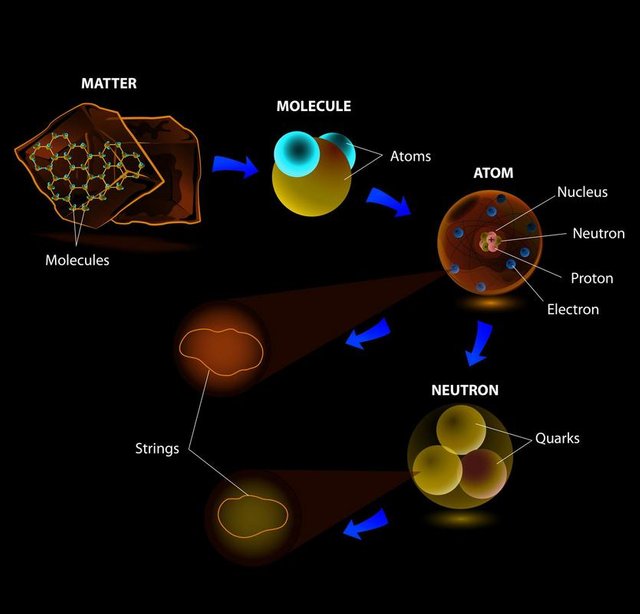String Theory II [A new concept]

This is the second article devoted to string theory. In the previous article, we discussed a conflict that causes considerable problems in theoretical physics. The knowledge collected so far on the subject of matter (partially), fundamental interactions, and particles transferring these interactions has also been described. Returning to the question from the previous article, which concerned the characteristic features of the Universe, let's try to get acquainted with the concept of string theory. I invite you to read.
A new concept
String theory has generated interest among others because it modifies the previously recognized image of matter. The previous article made us realize that the more we try to enter the structure of an object, then at sufficiently small distances we will begin to notice the atoms from which it is built. With a larger approximation, we notice the internal structure of the atom, which consists of protons, neutrons and electrons. Protons and neutrons reveal their interior in the form of quarks. String theory introduces one more level to this structure. It shows that when we try to examine the internal structure of the quarks, a thin vibrating string will appear. This means that the string theory predicts that everything is composed of tiny dancing strings.


For a long time, when it was discovered that everything is a manifestation of four fundamental interactions, scientists began to work on their unification. This was due, among others, to Maxwell, who made the unification of electricity and magnetism, which were regarded before him as two different types of interactions. He showed that both of these forces are really a manifestation of one electromagnetic interaction. This is how the Maxwell's electrodynamics were created (the picture shows four Maxwell equations fully describing electricity and magnetism). Nowadays, scientists are working on so-called quantum field theories that try to generalize quantum mechanics to be consistent with a special theory of relativity. An example of quantum field theory is quantum electrodynamics, which is a generalization of Maxwell's classical electrodynamics, electroweak theory of interaction that generalizes weak interactions and quantum electrodynamics, quantum chromodynamics describing a strong interaction, or a standard model that describes all three basic interactions (except gravity). As mentioned before, string theory is also a potential candidate for a theory that combines all basic interactions. And all this by introducing the concept of the string. In fact, this is what is happening. It allows us to describe all interactions, so we can potentially be called her the theory of everything. However, let us not be too astounded. Many people think that the theory of everything will explain to us literally everything from the movement of the smallest particles to the eruptions of volcanoes and give us a tool to describe all phenomena. Fortunately, it will not happen. Even if we discover the theory of everything and manage to write down all basic influences, using a set of equations, or using one universal equation, this will be just the beginning of our journey to new discoveries. It is not the end. The universe is too rich for amazing phenomena and there will always be something to discover. Today, string theory develops at a surprisingly fast pace, but it does not change the fact that scientists are still waiting a long way to finish it up. Nevertheless, it has already shown us many amazing phenomena. The difficult task is to present her elegance with which string theory translates the seemingly insignificant features of the Universe, related to elementary particles and forces. It does it in a way that no other theory has done. According to it, the characteristics of individual particles and the properties of forces result from some subtle features of the Universe geometry, which is a complicated multi-dimensional maze in which the strings twitch, bend and intertwine creating a ground for the time and space we know. Our Universe according to string theory is nothing but a melody that plays the role of a creator. This comparison is due to the fact that string theory describes all kinds of particles as different frequency vibrations of the string. In other words, every particle we know corresponds to a vibrating string with a unique frequency. As it turns out, then not only does the string play an important role and we will learn about other types of objects that are required for the string theory to describe our strange world.

Before we begin to thoroughly discuss the concepts and phenomena resulting from string theory, we must become familiar with the history of its creation and prepare for the changes that it introduces to understanding reality. Remember, however, that this is a pure theory that has not yet been learned enough to give us answers to all the questions which string theory generated. Scientists have only approximate equations that are already so complicated that we have to work on a new mathematics. We do not know, therefore, whether string theory is a dead end or a way to a deeper understanding of the universe. Theorists are convinced that it is more than just a claptrap. You'll judge for yourself.
Table of Contents:
Additional information:
Maxwell electrodynamics
Quantum electrodynamics
Quantum chromodynamics
Electroweak interactions
Source of pictures:
This is the English translation of my Polish article which is available here
Next articles coming soon. Thank you!